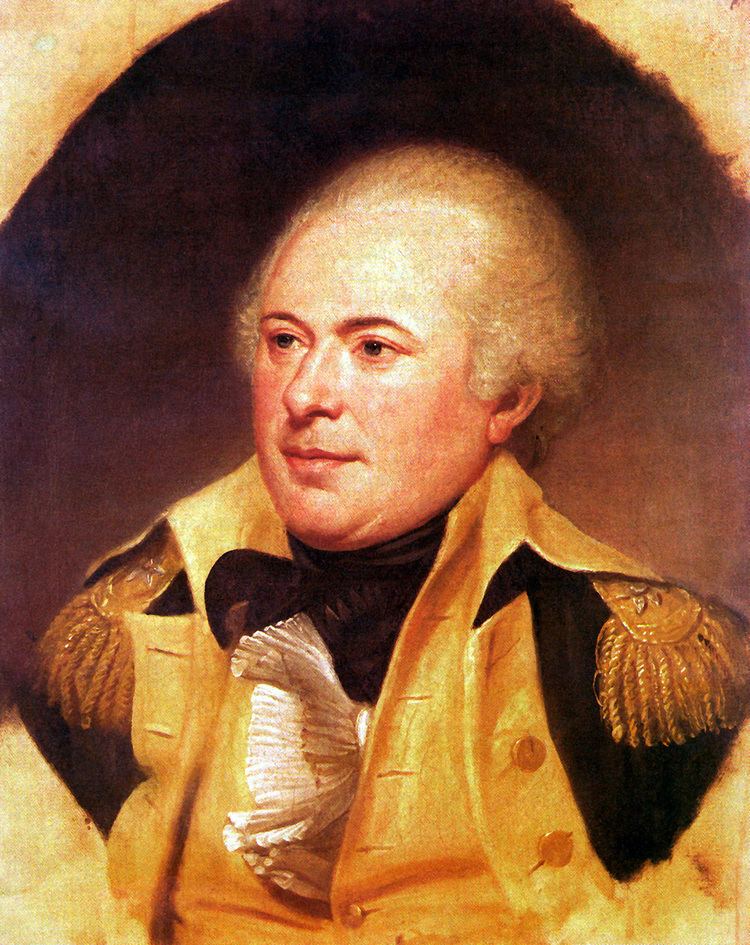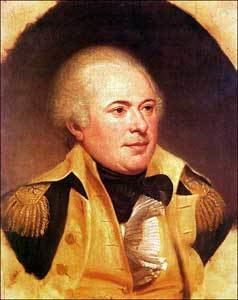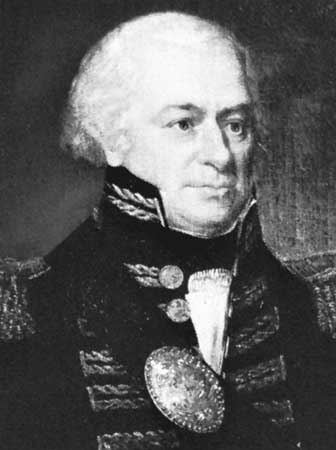Name James Wilkinson | ||
 | ||
President John AdamsThomas JeffersonJames Madison Spouse Ann Biddle Wilkinson (m. 1778) Books Memoirs of My Own Times (3 Volumes) Similar People | ||
James Wilkinson
James Wilkinson (March 24, 1757 – December 28, 1825) was an American soldier and statesman, who was associated with several scandals and controversies.
Contents
- James Wilkinson
- James Wilkinson Tennis Smart Video
- Personal life
- Revolutionary War service
- Kentucky ventures
- Second military career
- Rivalry with Wayne
- Quasi war with France
- Service under President Jefferson
- Connections with Aaron Burr
- War of 1812
- Last years
- Legacy
- In popular culture
- References
He served in the Continental Army during the American Revolutionary War, but he was twice compelled to resign. He was twice the Senior Officer of the U.S. Army, appointed to be the first Governor of the Louisiana Territory in 1805, and commanded two unsuccessful campaigns in the St. Lawrence River theater during the War of 1812. After his death, he was discovered to have been a paid agent of the Spanish crown.

James Wilkinson Tennis Smart Video
Personal life

James Wilkinson was born about three miles (5 km) northeast of Benedict, Maryland, on a farm south of Hunting Creek. His grandfather had been sufficiently wealthy to buy a large property known as Stoakley Manor in Calvert County. The family felt that even though their property was smaller, they still fell in with a higher social class. James grew up with the idea that "the image of respectability excused the reality of betrayal". His father, Joseph Wilkinson, inherited the property but, by that time, the family was in debt. In 1764, Stoakley Manor was broken up and sold. His older brother, Joseph, inherited the property after his father died and, as the second son, James was left with nothing.
Historian Andro Linklater argued that his upbringing led to James' aggressive reaction towards insults of his behavior. His father had left with the last words of "My son, if you ever put up with an insult, I will disinherit you."
Wilkinson received his early education from a private tutor, funded by his grandmother; his study of medicine in Philadelphia at the University of Pennsylvania was interrupted by the American Revolutionary War.
Wilkinson married Ann Biddle of the prominent Biddle family of Philadelphia on November 12, 1778 in Philadelphia. Wilkinson's marriage to the dynamic Biddle helped him develop his career as a politician and general. They had four sons, including John (1780–1796), James Biddle (c. 1783 – September 17, 1813), Joseph Biddle (1789–1865), and Walter (born 1791). James and Walter both served as Captains in the US Army.
After Ann's death on February 23, 1807, he married Celestine Laveau Trudeau, daughter of New Orleans' 1812 mayor Charles Laveau Trudeau, on March 5, 1810, with whom he had three children: twin girls Stephanie and Theofannie, born January 1816, and a son Theodore, born 1819. Theofannie, his favorite, died in early 1822.
General Wilkinson died on December 28, 1825, at the age of 68. He was buried in Mexico City, Mexico.
Revolutionary War service
Wilkinson first served in Thompson's Pennsylvania rifle battalion, 1775–76, and was commissioned a captain in September 1775. He served as an aide to Nathanael Greene during the Siege of Boston, participated in the placing of guns on the Dorchester Heights in March 1776, and following the British abandonment of Boston, went with the rest of the Continental Army to New York where he left Greene's staff and was given command of an infantry company.
Sent to Canada as part of the reinforcements for Benedict Arnold's army besieging Quebec, he arrived just in time to witness the arrival of 8,000 British reinforcements under General John Burgoyne – which precipitated the collapse of the American effort in Canada. He became aide to Arnold just prior to the final retreat and left Canada with Arnold on the very last boat out. Shortly thereafter, he left Arnold's service and became an aide to General Horatio Gates in August 1776.
When Gates sent him to Congress with official dispatches about the victory at the Battle of Saratoga in 1777, Wilkinson kept Congress waiting while he attended to personal affairs. When he finally showed up, he embellished his own role in the victory, and was brevetted as a brigadier general (despite being only 20 years old at the time) on November 6, 1777, and appointed to the newly created Board of War. The promotion over more senior colonels caused an uproar among Continental officers, especially because Wilkinson's gossiping seemed to indicate he was a participant in the Conway Cabal, a conspiracy to replace George Washington with Horatio Gates as commander-in-chief of the Continental Army. Gates soon had enough of Wilkinson, and the young officer was compelled to resign in March 1778. On July 29, 1779, Congress appointed him clothier-general of the Army, but he resigned on March 27, 1781, due to his "lack of aptitude for the job".
Kentucky ventures
After his resignation from the Continental Army, Wilkinson reluctantly became a brigadier general in the Pennsylvania militia in 1782 and also a state assemblyman in 1783, due to the wishes of George Washington. He moved to Kentucky (at that time, just three counties still belonging to Virginia) in 1784, and he was active there in efforts to achieve independence from Virginia.
In April 1787, Wilkinson made a highly controversial trip to New Orleans, which was the capital of Spanish colonial Louisiana. At that time, Americans were allowed to trade on the Mississippi River, but they had to pay a hefty tariff. Wilkinson met with Spanish Governor Esteban Rodriguez Miro and managed to convince him to allow Kentucky to have a trading monopoly on the River; in return he promised to promote Spanish interests in the west. On August 22, 1787, Wilkinson signed an expatriation declaration and swore allegiance to the King of Spain to satisfy his own commercial needs. The "Spanish Conspiracy", as it is known, was initiated by Wilkinson's "First Memorial", a 7,500-word report written before he left New Orleans for Charleston, to the Spanish concerning the "political future of western settlers" and to convince Spain to "admit us [Kentuckians] under protection as vassals". This was encoded with myriad symbols, numbers, and letters that was decoded via a complex English-Spanish cipher code-named "Number 13", which became the basis for his pseudonym, "Agent 13".
Upon returning to Kentucky in February 1788, Wilkinson vigorously opposed the new U.S. Constitution. Kentucky had very nearly achieved statehood under the old Articles of Confederation, and there was widespread disappointment when this was delayed because of the new constitution.
Leading up to Kentucky's seventh convention regarding separation from Virginia in November 1788, Wilkinson attempted to gauge the support for Kentucky to seek union with Spain. Wilkinson's ability to win people over with his charm and sincerity got him elected committee chairman at the convention. He advocated for Kentucky to seek independence from Virginia first, and then to consider joining the Union of states as a second step. For many, joining the Union was conditional upon the Union negotiating with Spain to arrange free navigation on the Mississippi River, a contentious point which many doubted the eastern states would act upon.
Unable to gather enough support for his position at the convention, Wilkinson then approached Miro with a proposal. His intention was to obtain a grant of 60,000 acres (243 km²) in the Yazoo lands, at the junction of the Yazoo River and the Mississippi (near present-day Vicksburg). The land was to serve as payment for Wilkinson's efforts on behalf of Spain, and to serve as a refuge in the event he and his supporters had to flee from the United States. Wilkinson asked for and received a pension of $7,000 from Miro, while requesting pensions on behalf of several prominent Kentuckians, including: Harry Innes, Benjamin Sebastian, John Brown, Caleb Wallace, Benjamin Logan, Isaac Shelby, George Muter, George Nicholas, and even Humphrey Marshall (who at one time was a bitter rival of Wilkinson's).
However, by 1788 Wilkinson had apparently lost the confidence of officials in Spain. Miro was not to grant any of the proposed pensions and was forbidden from giving money to support a revolution in Kentucky. Furthermore, Wilkinson continued to secretly receive funds from Spain for many years.
Second military career
In the Northwest Indian War, Colonel Wilkinson led a force of Kentucky volunteers against American Indians at Ouiatenon in May 1791. He commanded a follow-up raid that autumn, highlighted by the Battle of Kenapacomaqua. In October he received a commission to the U.S. Army as lieutenant colonel, commandant of the 2nd U.S. Infantry.
Rivalry with Wayne
When the United States government reorganized the Army as the Legion of the United States, President George Washington was faced with the decision of whom to name as its commanding general. The two major candidates for this promotion were Wilkinson and Anthony Wayne. In the end, the cabinet chose Wayne due to Wilkinson's suspected involvement with the Spanish government. The cabinet promoted Wilkinson to brigadier general as consolation, since the President was aware of Wilkinson's fragile ego.
Wilkinson developed a jealousy of Wayne, but he maintained an ostensible respect toward the general. However, upon Wilkinson's refusal of an invitation to Wayne's Christmas party, Wayne developed a full-fledged hatred for Wilkinson, deeming the refusal to be an act of disrespect. For example, Wayne had led the Legion Army against the Native Americans in the Battle of Fallen Timbers in August 1794. This battle was a huge victory for the United States, yet Wilkinson had criticized General Wayne's actions during the battle, simply to antagonize him.
Wilkinson proceeded to file formal complaints with President Washington, against Wayne and his decisions. Upon finding out about the complaints against him, Wayne decided to fight back, launching an investigation into Wilkinson's history with the Spanish. During all of this time, Wilkinson had renewed his secret alliance with the Spanish government (through the Governor of Louisiana Francisco Luis Hector de Carondelet), alerting them to the actions of both the US and the French occupancy in North America. When Spanish couriers were intercepted carrying payments for Wilkinson, Wayne's suspicions were confirmed and he attempted to court martial Wilkinson for his treachery. However, Wayne developed a stomach ulcer and died on December 15, 1796.
In spite of Wilkinson's nearly-confirmed treason, upon Wayne's death he began his first tenure as Senior Officer of the Army, which lasted for about a year and a half.
Quasi-war with France
Wilkinson was transferred to the southern frontier in 1798. During the Quasi-War crisis of the late 1790s between France and the United States, he was given the third-place rank in the U.S. Army behind George Washington (who, having been succeeded as President by Adams, died in December of 1799) and Alexander Hamilton. Among other duties, Wilkinson was charged by Hamilton with establishing a "Reserve Corps" of American troops in the lower Ohio River Valley, who would seize the lower Mississippi River Valley and New Orleans in the event of war with France and her ally Spain.
Despite the end of the crisis in mid-1800 and Hamilton being discharged from the Army, Wilkinson, for unknown reasons, continued the plan for the establishment of the base which he named "Cantonment Wilkinson" after himself. Located in the Indiana Territory (now southern Illinois), the base operated from January 1801 to late 1802 before finally being abandoned. Archaeologists from Southern Illinois University have located the remains of this base, which is producing much previously-unknown information and artifacts from the daily life of the frontier army.
Wilkinson served his second, longer term as Senior Officer of the Army from June 15, 1800, until January 27, 1812, when former Secretary of War Henry Dearborn was promoted to major general over Wilkinson.
Service under President Jefferson
Wilkinson remained senior officer of the United States Army under President Thomas Jefferson. Along with Governor William C. C. Claiborne, Wilkinson shared the honor of taking possession of the Louisiana Purchase on behalf of the United States in 1803. At this time, Wilkinson renewed his treasonous relationship with Spanish colonial officials, offering advice to them on how to contain American expansion in exchange for the restoration of his pension. Among other things, Wilkinson tipped off the Spanish to the object of the Lewis and Clark expedition.
Connections with Aaron Burr
In 1804–05, he met in person with Aaron Burr and they exchanged letters regarding the Burr's conspiracy. After Burr's arrest he claimed he was leading a group of settlers to take up residence on land in Texas which he had leased from the Spanish government in Mexico, while the government charged him with treason and claimed he intended to separate the then-western states and territories from the United States and establish an independent nation.
Wilkinson was both the senior brigadier general of the United States Army and the Governor of Missouri Territory, which made him someone whose support Burr would cultivate.
In 1806 Burr is supposed to have sent a coded, unsigned letter (the "Cipher Letter", which Burr later denied having written) to Wilkinson, which stated that he was ready to commence his movement to Texas. Burr's subsequent efforts to recruit participants in his plans became public, raising fears that he was conspiring with England to start a war with Spain. Wilkinson became fearful that his role in Burr's plans and/or his spying for Spain would be exposed. In October 1806 Wilkinson sent to President Jefferson a letter in which he painted Burr's actions in the worst possible light, while portraying himself as innocent of any involvement. Jefferson ordered Burr's arrest, and Burr was apprehended near Natchez, Mississippi.
Wilkinson testified at Burr's trial, and the documents presented as evidence included the "cipher letter", which Wilkinson had given the prosecution. However the letter was clearly altered to minimize Wilkinson's culpability. This forgery, coupled with Wilkinson's obviously self-serving testimony, had the effect of making Burr seem to be the victim of an overzealous government. The grand jury nearly produced enough votes in favor of indicting Wilkinson for misprision of treason, and foreman John Randolph said of Wilkinson that he was a "mammoth of iniquity" and "the only man I ever saw who was from the bark to the very core a villain."
He was removed from the Territorial Governor's office after being publicly criticized for heavy-handed administration and abuse of power (and replaced with Meriwether Lewis).
In addition, his actions around the Burr conspiracy became public, which aroused the public against him and led to two Congressional inquiries into his private ventures and intrigues. President James Madison, who had succeeded Jefferson in 1809, ordered a military court of inquiry in 1811, which exonerated Wilkinson.
War of 1812
Wilkinson was commissioned a major general during the War of 1812 on March 2, 1813. That same month, Wilkinson led the American force which occupied Mobile in Spanish West Florida, effectively implementing the inclusion of the Mobile District in the Mississippi Territory.
He was then assigned to the St. Lawrence River theater of war, following Henry Dearborn's reassignment. Wilkinson engaged in two failed campaigns (the Battle of Crysler's Farm and the second Battle of Lacolle Mills (1814)). He was then relieved from active duty, but he was cleared in a military inquiry. He was discharged from the Army on June 15, 1815. In 1816, Wilkinson published Memoirs of My Own Times, in a final attempt to clear his name.
Last years
After the end of his military career, Wilkinson was appointed as U.S. Envoy to Mexico. This was during the period of the Mexican War of Independence against Spain, which was won in 1821. In that year, Wilkinson requested a Texas land grant. While awaiting the Mexican government's approval of his land scheme, Wilkinson died in Mexico City, where he was buried.
Wilkinson's involvement with the Spanish (Agent 13) was widely suspected in his own day, but it was not proven until 1854, with Louisiana historian Charles Gayarre's publication of the American general's correspondence with Esteban Rodriguez Miro, Louisiana's colonial governor between 1785 and 1791. Other historians subsequently added to the catalog of Wilkinson's treasonous activities.
According to Burr biographer David O. Stewart, Wilkinson was severely condemned in print by then-Governor of New York Theodore Roosevelt, some 65 years after the general's misdeeds, with this judgment: "In all our history, there is no more despicable character."
